deployment of the PLA Navy ships in the - Information Resource ...
deployment of the PLA Navy ships in the - Information Resource ...
deployment of the PLA Navy ships in the - Information Resource ...
Create successful ePaper yourself
Turn your PDF publications into a flip-book with our unique Google optimized e-Paper software.
NAVAL DESPATCH<br />
FFFFFFFFFFFFFFFFFFF<br />
Strike force, <strong>ships</strong> with long range weapons<br />
could launch stand<strong>of</strong>f weapons or use <strong>the</strong><br />
tactical mobility to close adversary's shore to<br />
launch <strong>the</strong>ir weapons, and submar<strong>in</strong>es could<br />
be deployed based on <strong>the</strong>ir weapon range to<br />
ensure assured retaliation.<br />
• Number <strong>of</strong> Platforms. Consider<strong>in</strong>g <strong>the</strong><br />
factors <strong>of</strong> limited mobility <strong>in</strong>case <strong>of</strong> land vectors<br />
and availability <strong>of</strong> <strong>in</strong>telligence on land and air<br />
vectors; <strong>the</strong> dispersion and <strong>the</strong> number <strong>of</strong> land/<br />
air vectors required to ensure sufficient<br />
survivability would be large. However, <strong>in</strong>case <strong>of</strong><br />
sea vectors <strong>the</strong> <strong>in</strong>herent advantages <strong>of</strong><br />
identification problems <strong>in</strong> <strong>in</strong>ternational waters<br />
and stealth provided by submar<strong>in</strong>es due<br />
submerged capability would require fewer units<br />
to ensure <strong>the</strong> same degree <strong>of</strong> survivability.<br />
• Command & Control Network. For<br />
C2 network<strong>in</strong>g Land and Air vectors have <strong>the</strong><br />
advantage <strong>of</strong> secure land l<strong>in</strong>es/ physical<br />
connectivity <strong>in</strong> addition to wireless and satellite<br />
communications. Land based vectors are more<br />
susceptible to EMP and DE weapons than Sea<br />
vectors due to <strong>the</strong>ir lack <strong>of</strong> mobility. Sea Vectors<br />
are restricted to established satellite<br />
communication and o<strong>the</strong>r traditional wireless<br />
communication networks with limited security.<br />
In <strong>the</strong> case <strong>of</strong> submar<strong>in</strong>es, due <strong>the</strong>ir <strong>in</strong>herent<br />
submerged operations pass<strong>in</strong>g <strong>of</strong> <strong>in</strong>fo/<br />
commands after a First Strike could be severely<br />
limited consider<strong>in</strong>g that land based VLF stations<br />
would also be a part <strong>of</strong> adversary's First Strike<br />
target list. A few ways to obviate this severe<br />
handicap could be to decentralise development<br />
<strong>of</strong> airborne VLF assets.<br />
• Escort Requirements. Consider<strong>in</strong>g <strong>the</strong>ir<br />
strategic nature, all three vectors would require<br />
a certa<strong>in</strong> amount <strong>of</strong> escort<strong>in</strong>g. This would mean<br />
anti-air and anti-missile protection for all three<br />
vectors and additionally anti-submar<strong>in</strong>e<br />
protection for <strong>ships</strong> at sea. However, <strong>in</strong> case <strong>of</strong><br />
availability <strong>of</strong> a large number <strong>of</strong> nuclear assets,<br />
<strong>the</strong> option <strong>of</strong> some <strong>of</strong> <strong>the</strong>m especially <strong>ships</strong> be<strong>in</strong>g<br />
deployed unescorted for tactical reasons such<br />
as availability <strong>of</strong> <strong>in</strong>tegral anti-air, anti-missile and<br />
even anti-submar<strong>in</strong>e defence systems could be<br />
considered. These unescorted <strong>ships</strong> would <strong>the</strong>n<br />
prove difficult to identify and target, however,<br />
chance encounters should be factored <strong>in</strong>to <strong>the</strong><br />
survivability calculations.<br />
• Logistic Requirements. The logistical<br />
<strong>in</strong>frastructure requirements for bas<strong>in</strong>g and<br />
relocat<strong>in</strong>g <strong>of</strong> Land vectors <strong>in</strong>clud<strong>in</strong>g <strong>the</strong> need<br />
for <strong>in</strong>tegral C3 <strong>in</strong>frastructure would require<br />
significant noticeable build up at all primary/<br />
alternate sites. Similarly, for operation <strong>of</strong> Air<br />
vectors, significant logistics build up would be<br />
necessary to susta<strong>in</strong> operations at <strong>the</strong> primary<br />
and alternate air bases. These would <strong>the</strong>n assist<br />
adversary's identification and target<strong>in</strong>g<br />
problems. However, sea vectors are designed<br />
to be self conta<strong>in</strong>ed/ <strong>in</strong>dependent and can<br />
susta<strong>in</strong> at sea for prolonged durations, sufficient<br />
to ensure an assured Second Strike.<br />
Summation <strong>of</strong> Vector Analysis<br />
Land vectors have <strong>the</strong> advantage <strong>of</strong> secured<br />
l<strong>in</strong>es <strong>of</strong> communication and physical proximity to C2<br />
<strong>in</strong>frastructure. However, <strong>the</strong>y are limited to land<br />
boundaries, subject to easier identification and<br />
restricted <strong>in</strong> mobility due requirement <strong>of</strong> road/ rail<br />
network.<br />
Air vectors enjoy <strong>the</strong> advantage <strong>of</strong> high speed<br />
and less reaction time. However, <strong>the</strong>y are subject to<br />
target<strong>in</strong>g on ground dur<strong>in</strong>g a First Strike and over<br />
enemy airspace dur<strong>in</strong>g <strong>the</strong> Second Strike. Moreover,<br />
Air vectors need significant logistic support for<br />
susta<strong>in</strong>ed ops from primary/ alternate bases.<br />
Sea vectors on <strong>the</strong> o<strong>the</strong>r hand are <strong>in</strong>dependent,<br />
difficult to identify, less susceptible to WMD, <strong>of</strong>fer high<br />
mobility, can close enemy shore for weapon launch<br />
rema<strong>in</strong><strong>in</strong>g <strong>in</strong> <strong>in</strong>ternational waters and can susta<strong>in</strong> ops<br />
for long durations. Carrier borne aircraft could be<br />
deployed to deliver Second Strike weapons swiftly<br />
while keep<strong>in</strong>g <strong>the</strong> Carrier Task Force beyond<br />
adversary's weapon range. However, <strong>ships</strong> rely on<br />
Satellite Communication for vital C2 <strong>in</strong>formation and<br />
submar<strong>in</strong>es are fur<strong>the</strong>r restricted <strong>in</strong> ability to exchange<br />
<strong>in</strong>formation while rema<strong>in</strong><strong>in</strong>g submerged.<br />
Additionally <strong>ships</strong> would require protection <strong>in</strong> all three<br />
dimensions to ensure assured delivery <strong>of</strong> <strong>the</strong> weapons<br />
FFFFFFFFF SEPTEMBER 2010<br />
FFFFFFFFF37



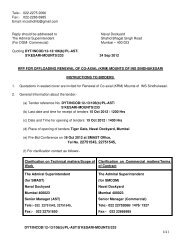

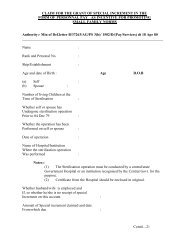
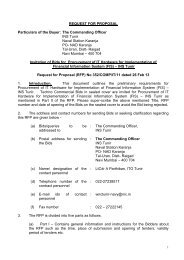
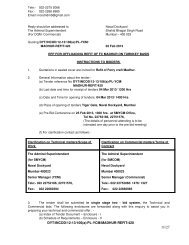
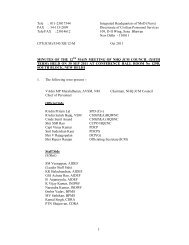
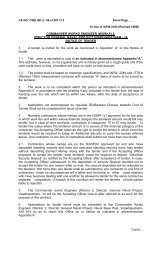

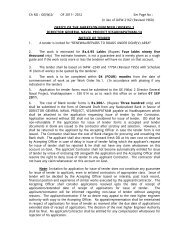
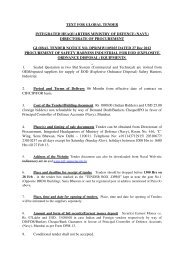
![DGNP[V] - Irfc-nausena.nic.in](https://img.yumpu.com/23509938/1/158x260/dgnpv-irfc-nausenanicin.jpg?quality=85)



